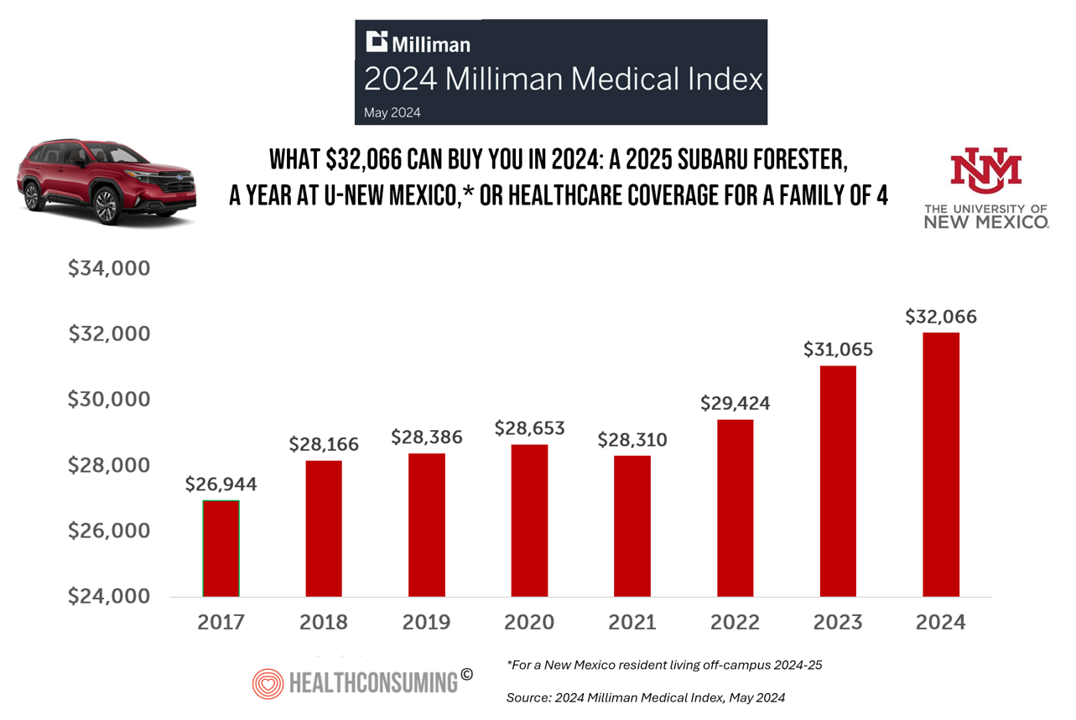Health care costs for an “average” person covered by an employer-sponsored PPO in the U.S. rose 6.7% between 2023 and 2024, according to the 2024 Milliman Medical Index. Milliman also calculated that the largest driver of cost increase in health care, accounting for nearly one-half of medical cost increases, was pharmacy, the cost of prescription drugs, which grew 13% in the year. 
The big number this year is $32,066, which is the cost of that employer-sponsored PPO for a family of 4 in 2024.
I’ve curated the chart of the MMI statistic for many years, resulting in this version for which I researched other household spending priorities a family might also buy for $32,066. This year, I opted for a 2025 Subaru Forester and a year’s tuition for a New Mexico resident living off-campus for 2023-24 attending University of New Mexico.

As an Index, the MMI combines several line items of healthcare spending to make up the overall number, and this methodology allows us to compare the rising costs of care for a family of 4 covered by a PPO year to year.
This year, the largest cost component in the Index was outpatient facility care making up about $1 in every $3 dollars of medical spending, followed by professional services (29%), pharmacy (20%), and inpatient care (17%). These numbers are for one “average” person covered by an employer via PPO.
There is a complex methodology that underlies the MMI, which I recommend you visit and filter through your own health care industry planning priorities and lens.
Health Populi’s Hot Points: The patient is now a key payer in the healthcare payments ecosystem, seeking value and return-on-personal investment akin to their employer also looking for value-satisfaction.
Milliman found that in 2024, the health-insured employee for an average person/family member is paying 26% of health care costs and 16% out-of-pocket, and employers cover 58% of healthcare costs in general.
Multiply that shared amount by 4 to envision a family of four’s costs, and you get $12,132 — a large chunk of household spending that can crowd out other family budget items from paying a utility bill to buying school supplies, taking a vacation, or filling a gas/petrol tank.
This speaks to the phenomenon of the patient-as-payer “feeling” the pinch of health care costs in this era of a “vibe”-cession — not necessary technically a recession, but a collective consumer ennui about inflation (say, for food shopping) or college education tuition.
We’ll be brainstorming the health consumer in 2030 in my panel at AHIP meeting on Thursday morning 13th June at 11 am — and I’ll be in great company with Don Antonucci, CEO of Providence Health, Dr. David Rhew, Chief Medical Officer with Microsoft, and Dr. Marc Watkins, Chief Medical Officer with Kroger Health. If you’re attending #AHIP2024, pls join us at 11 am in the Musigny Room in the Wynn convention space — it’s sure to be a great conversation….
I’ve covered the MMI updates every year for many years here on Health Populi. You can see past posts of the MMI at the following links, and for assessments before 2020, you can click into the search box at the top for previous looks at the MMI…






 Gil Bashe, Chair Global Health and Purpose with FINN Partners,
Gil Bashe, Chair Global Health and Purpose with FINN Partners,  Grateful to Gregg Malkary for inviting me to join his podcast
Grateful to Gregg Malkary for inviting me to join his podcast